Welcome to the latest issue of Feed the Monster, a monthly art journal for the creative and imperfect. Come as you are.
Click on the ❤️🔥 above if you want to help this publication grow!
You can read more about FTM here. If you like it, please consider subscribing.

HELLO and welcome to all my new subscribers! It means the world to me that you’re here, and I ain’t whistling dixie. This month’s post is an archive dive to a time long, long ago… or at least, that’s how it feels. It’s from November 2021.
Revisiting this post about Clown School has made me think a lot about vulnerability, which in turn had me revisit this Ted Talk by Brené Brown from 2010 (it’s twenty minutes long… please watch it). I’ll never express this as well as Brown does, but basically, allowing yourself to be vulnerable opens you up to the possibility of pain, yes—but in equal measure it opens you up to the possibility of joy. You can’t feel joy if you’re too busy avoiding pain.
Brown has also made much of the Theodore Roosevelt quote that says if you’re putting yourself out there, doing something, making something, risking failure, allowing yourself to be vulnerable… well then screw your critics (not his exact words). If those critics aren’t also throwing themselves into the arena, you don’t have to listen to a goddamn word they say.
I learned a lot about putting myself out there from my husband David P. Smith, a man of many talents. A songwriter, a musician, a performer, a painter… a true artist, as I’ve always said. More to the point, a man who’s always been unafraid to express himself just exactly as he pleases. With his encouragement, I stood on a stage and sang for the first time at the age of 42. And you can be sure I wouldn’t have braved Clown School if I weren’t with him.
One thing I’ve learned about being vulnerable: it won’t kill you. Oh yes, it can be excruciating, lol. Any risk you take, any deviation from your usual patterns or your comfort zone will cause discomfort, sometimes extreme. But it’ll also make you feel ALIVE in a way that staying safe certainly never will. Says the woman who still can’t believe that she went to…
CLOWN SCHOOL
Anyone who knows me will understand that what I did last weekend is not merely outside my comfort zone. It’s… well… it’s not even visible from my comfort zone.
I went to Clown School.
I went because the teacher Britt Small, co-founder and artistic producer of Atomic Vaudeville, is someone I admire. I don’t know her very well, but I’ve seen enough of what she does to be duly wowed. It isn’t only that she’s a powerhouse director, producer, performer, and teacher. In the words of Hank Pine, friend and collaborator of Small’s and himself an unnaturally talented Renaissance man:
I think one of the best things about Britt is that she’s a director in all aspects of her life.
She’s a curator and inspirer and director, and she has a singular vision. But she’s very willing to do whatever it takes to foster everyone else’s vision around her and make them a fully realized artist.
And that’s a rare, beautiful thing.
I also went because I read about Clown School a couple years back in a Yam Magazine article about Small by David Lennam. In that article, he writes:
For Small, clown work is a lot more serious than a pie in the face. It's timing, rhythm, and an almost mathematical devotion to finding those places where you stop the action to create the opportunity for comedy.
"One of the first exercises you do as a clown is be yourself," she says. "It's one of the hardest things to do."
Clown training, she explains, means being coached to do less and less, contrary to the all-action-all-the-time cliché. Being interested instead of interesting is key—interested in the audience, how they're responding to that.
"That's how you keep your presence very much alive in the room, as opposed to feeling like people are watching you. You see clowns; they're always clocking the audience (looking at them, measuring their response)."
Reading this, I had the sinking feeling that I needed Clown School. I’d been sporadically getting up to sing with my husband David P. Smith for almost twenty years, and it’d never gotten any easier. “Being interested instead of interesting” sounded like something I needed to learn: to have the courage and willingness to be open and receptive to the people in the audience rather than worrying about how they might perceive me or my voice.
Yikes.

I don’t know if I really thought I’d ever go through with it, but somehow David and I came to be enrolled in Clown School. I’ve never done anything remotely theatrical, and even pre-pandemic was content to spend my days working alone from home or in my studio. I have a handful of close friends and am not particularly gregarious. Being open to people I don’t know isn’t especially, uh, my thing. I knew this was a crazy-ass thing for me to do, but it was so crazy, it just might work.
I actually am a clown—ask my family and they’ll tell you—just not one who clowns for strangers. Would I be able to breach my fear of the audience?
I’m normally very nervous leading up to a singing gig. Leading up to Clown School, I didn’t feel much, which I attributed to having no idea what I was in for. In retrospect, I suspect I was actually petrified—turned to stone from fear in the face of the oncoming tsunami.
Somehow, I rode that tsunami all weekend.
Much of my memory of Clown School is blurred—I think I may have been hovering outside my body the entire time. It took place over three days: Friday night from 6:00 – 9:00 pm, and Saturday and Sunday from 2:00 – 6:00 pm. Clown School has a maximum of twelve participants (I notice that’s since been changed to ten—ed.)
Each session started with the group standing in a circle, playing games and doing exercises meant to warm us up, help us remember each other’s names, and prime us for maximum connection with others. Some of the participants had been to Clown School more than once, and some were complete newbies like myself and David.
After the circle, the first thing we played was Reverse Charades. One person leaves the room, and the people remaining decide on an action—for example, cutting a jack-o’-lantern, chopping down a tree, or picking your nose. The person who’d left re-enters the room, and without any clues tries to ascertain the chosen action by making movements and gestures while the audience indicates how “hot” or “cold” they are with sounds of encouragement or discouragement. No words are spoken. It forces you to pay attention to your audience—you must engage with them if you hope to get anywhere, because you’re truly starting with nothing. It’s not easy, to say the least.
Next was the dreaded “Present Yourself”. At least, I dreaded it. You enter the room and simply stand before everyone there. Nothing more. You look from person to person, making eye contact with each one. You stay present, if you can. I thought of Marina Abramovic and her 3-month long performance piece The Artist is Present—what it must have been like to look into people’s eyes six days a week for three months. I anticipated that I’d be uncomfortable feeling all the feelings of everyone I was locking eyes with, and I was right. Some people were very open and calm. Some were intense. And some were themselves embarrassed by the situation, creating a feedback loop of discomfort between us. As my eyes made the rounds looking from person to person, I didn’t look forward to “connecting” again with the uncomfortable ones.
Small paid close attention and intuitively guided each person through it. I kept reflexively looking down, causing her to remind me to “stay with us”. In fact I found myself looking down a lot during Clown School, at least during the first two days. These aren’t situations you can think your way out of, which is what I suspect I was instinctively trying to do. Or maybe I just couldn’t deal with what was happening and that was my way of attempting escape. A couple of people became emotional while they “presented themselves”, alerting me to the fact that I’d been on guard while doing it or I likely would have been similarly moved. Who can say?
Next there were exercises and challenges to do with exploring and expressing different emotions and changing them on a dime, and these required emoting and performing in front of the audience of participants. More than once I asked to go first—not just to get it over with, but also so that watching others perform wouldn’t make me fear being inadequate when my turn came. Riding that tsunami.
And then came time for us to become clowns.
In order to find your inner clown, Small leads you through a series of visualizations that help you come up with a sound and a movement. A sound and a movement all your own. That’s all that’s required. Once you have something you feel good about, you take it to her and she helps you develop it. This part of the process I can’t really explain apart from saying that she helps you make it moreso. My movement was a kind of flouncing up and down of the arms, and my sound was something like “la la la la LA.” You dig?
Next you go to a table of face paints and paint your own face, without looking. Then you go to Small’s tickle trunk and find an outfit. Quickly. This all happens quickly.
After finding a clown outfit, each person stomps around practicing their sound and movement, expressing themselves, sometimes crashing into each other or interacting with each other, causing me to have thoughts of, “Oh God… theatre people.” This designation began in high school: the drama people, the theatre people. A group I wasn’t part of; a group my friends and I rolled our eyes at. And now here I was among them, in clown costume and a face I’d painted blindly, waving my arms around and singing “LA LA LA LA LA” at full volume, fighting for space and adding my voice to the cacophony.
My, how the Judgy-Judgersons have fallen.
On day two we did “clown turns” in pairs. A clown turn is basically the name for what the clown, or clowns, do for their performance. The pair of you leave the room and quickly discuss your strategy—it’s all very off-the-cuff. One clown emerges first utilizing the sound and movement they discovered for themselves, then the second clown appears with their sound and movement and the two interact and play off each other.
Improvisation… shudder.
David and I paired up for this. I swear I have no memory of what the hell transpired on that studio floor, apart from exaggerated outrage on my part at some behaviour of his. This was more or less the schtick I was able to muster in that moment. The rest is lost to me. I only remember feeling panicked, as well as unsure about whether or not I was “doing it right”.
At the end of Saturday—day two—Small mentioned that we’d be doing solo clown turns on Sunday, and this caused me no small amount of anxiety. I thought I was home free after having done two days of Clown School and that nothing could throw me at that point, but no. I was thrown.
Saturday night I woke up in the middle of the night and ruminated on what must be wrong with me. It’s not news to me that I tend to be wary with people—I can have an instantaneous comfortable connection with someone, but I can as easily take 20 years to let someone in. Clown School had me laying awake worrying that I had a fatal flaw preventing me from “presenting myself” with ease, and that other people had a more normal ability to connect with others than I did. Clown School had gotten into my head. I was ready for it to be over at that point. I’d had enough. Fuck Clown School!
But that feeling didn’t last. I went to day three, and though my anxiety levels were high on arrival, everything unfolded better than I could have expected. When will I ever learn? I was still riding the tsunami and had no time to resist what was happening. THE SHOW MUST GO ON.
And so… I went on.
In my own words, which will surely be inadequate, clowning is primarily about being in the moment, and staying open to and in touch with the audience. It’s not so much about entertaining—though it will definitely be entertaining if executed well—as it is about reading the room and responding to both inner and outer cues in real time. Taking advantage of any opportunities presented; leaning in to any mishaps and making them work for you. Though I was scared senseless to do my solo clown turn, once in the middle of it I started to click in. I began to enter the zone. I started to instinctively play with timing and rhythm, and by the time it was over I felt like I was just getting started.
If I’d done Clown School twenty years ago when I was making my first tentative attempts at singing onstage, it probably would have helped immeasurably. It might have changed my life. As it’s possibly done anyway, though to what end at this point I’m not sure. It doesn’t matter. I would never normally say or even think this, but I feel proud of myself for having done it.
(Ew, I said it.)
I found Small to be an incredible teacher and facilitator. She explained and described the history and lineage of the clown traditions we were working with, which I can’t begin to attempt repeating here. She’s infinitely chill, while being 100% engaged. If I could have looked into only her eyes when I “presented myself”, I would have done so gladly. She’s obviously so sincerely and completely absorbed in the proceedings, not to mention delighted by them, that it’s infectious. There’s no competition, no judgement, no shame, no “better” or “worse”—except in your own mind. Always with the persnickety mind.
After finishing the three days I thought, “Now that I’ve done Clown School, I can do anything!” But I had that very thought after giving birth to my daughter, too. After that insanity, I was convinced that nothing else in my life could possibly challenge me. I could surely do ANYTHING.
But you forget. You’re definitely changed and you’ve done something incredible, but you forget.
Psst… you, too can go to Clown School. It’s where Jimbo the Drag Clown learned and honed his chops! And if you know Jimbo at all, you know he’s more clown than anything 🤡
SOME STUFF!
A mini-doc about the incredible painter Alice Neel
Creative addition and subtraction featuring The Talking Heads, via Austin Kleon
Django Jane by Janelle Monae - a video I was obsessed with when it came out about 5 years ago. Because it’s HEAVY
Bye! Thanks for reading. If you find value in my posts, please consider supporting me and my work by becoming a paid or free subscriber:
Or please like this by clicking on the little heart, share it, or make a comment—that helps support my work, too. Go on, take a chance—CLICK A HEART WHY DON’T YOU? Or LEAVE A COMMENT!
Buy my Collage Class—$40 CAD for a one-hour prerecorded download. People like it!
Listen to my interview with Sheryl MacKay on CBC’s NxNW here (starts ten minutes in). It’s all about Life’s Work: A Visual Memoir, an art exhibit about my mother’s Lewy Body dementia and my relationship with her
Buy my book 100 Days of The Artist is Present
Visit balampman.com
There's always Instagram





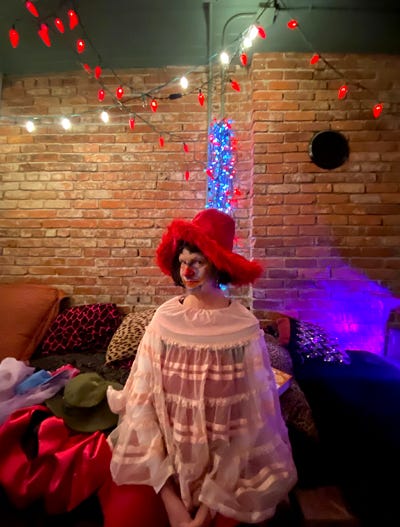
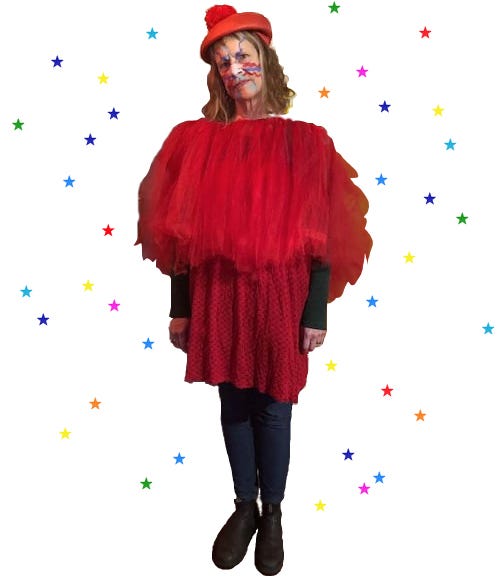
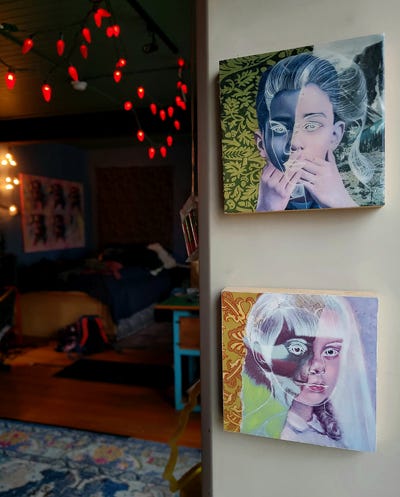

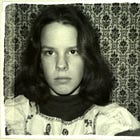
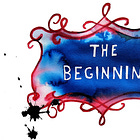
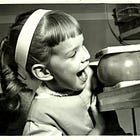
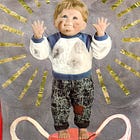
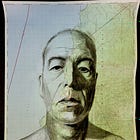

Wowza! I've always loved clowns ever since childhood and Red Skelton but going to school for it sounds as scary as the Stand Up Comedy class I took some years back. Maybe I should combine the two and become a Stand Up Comic Clown. Yikes. xoxo
I love the phrase "sensationally vulnerable" and all the reminders around vulnerability. Thanks, friend. xx